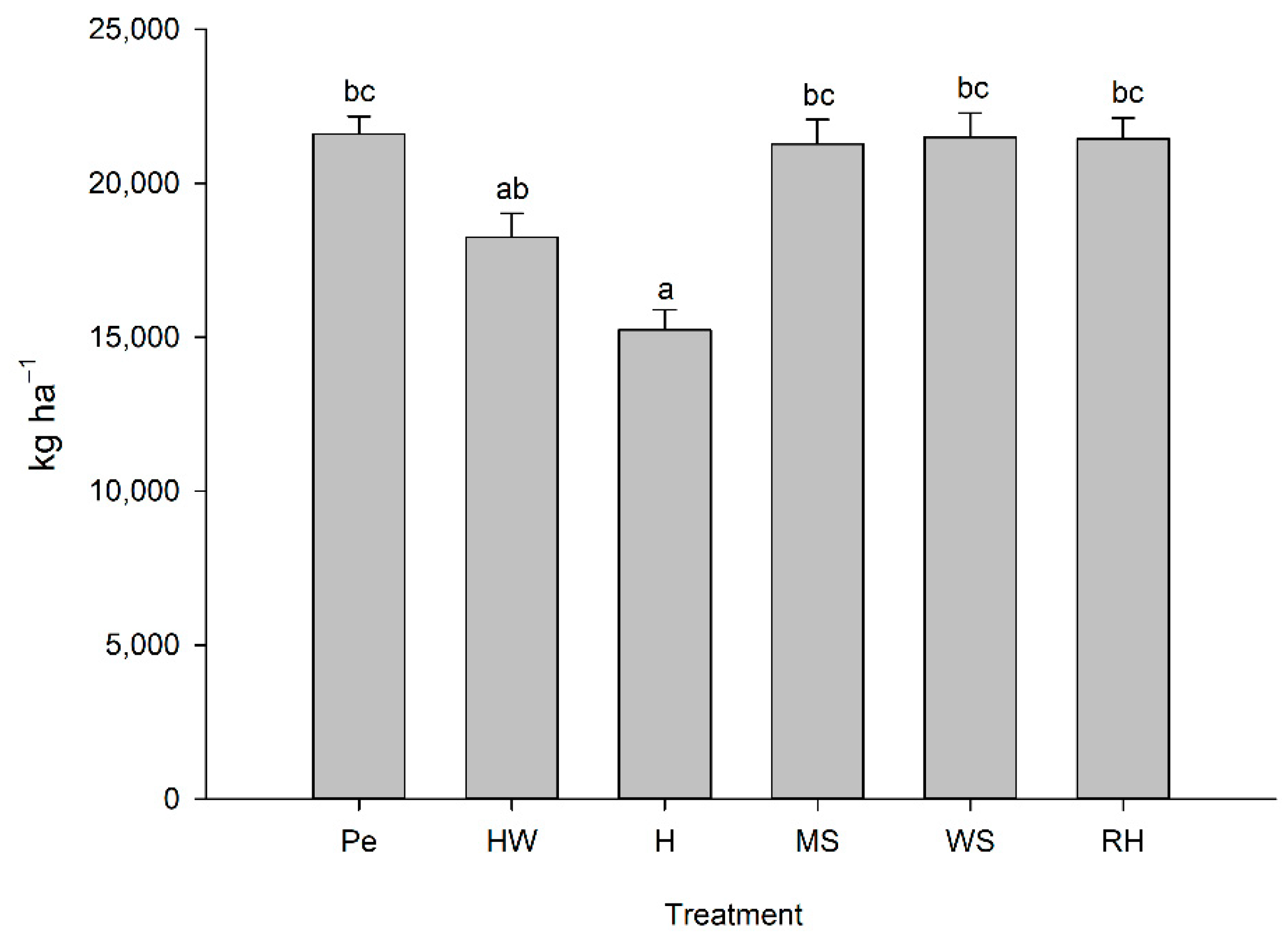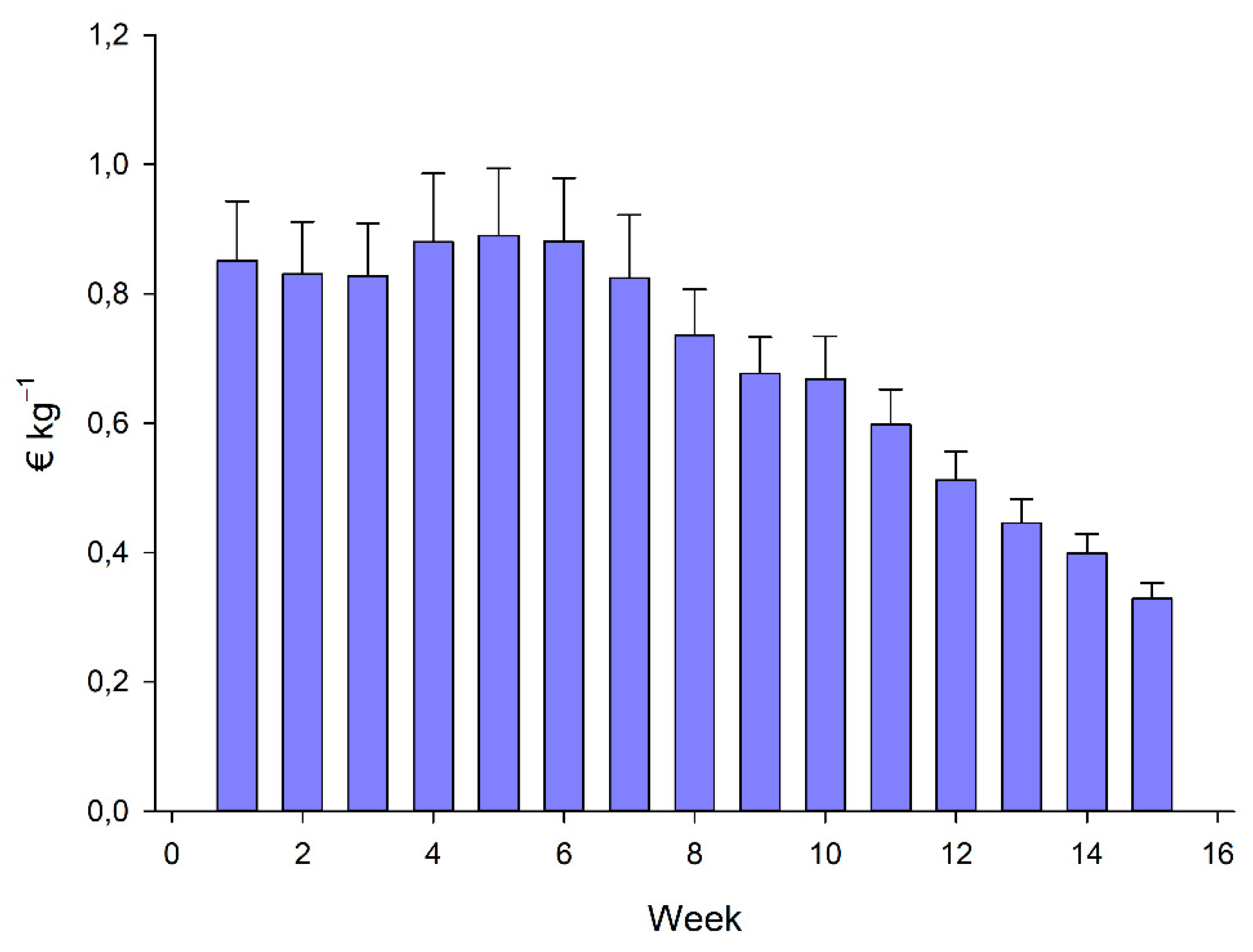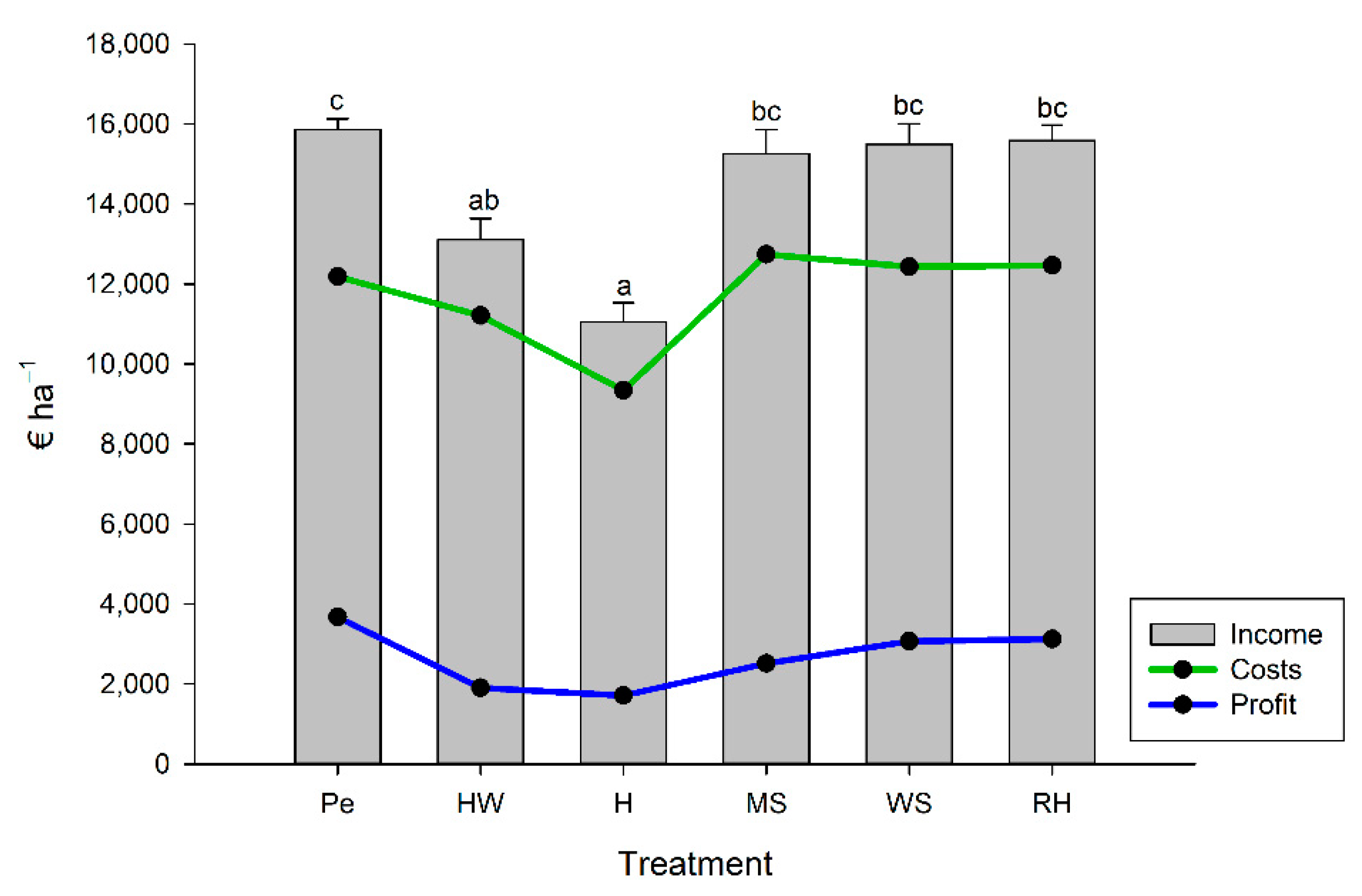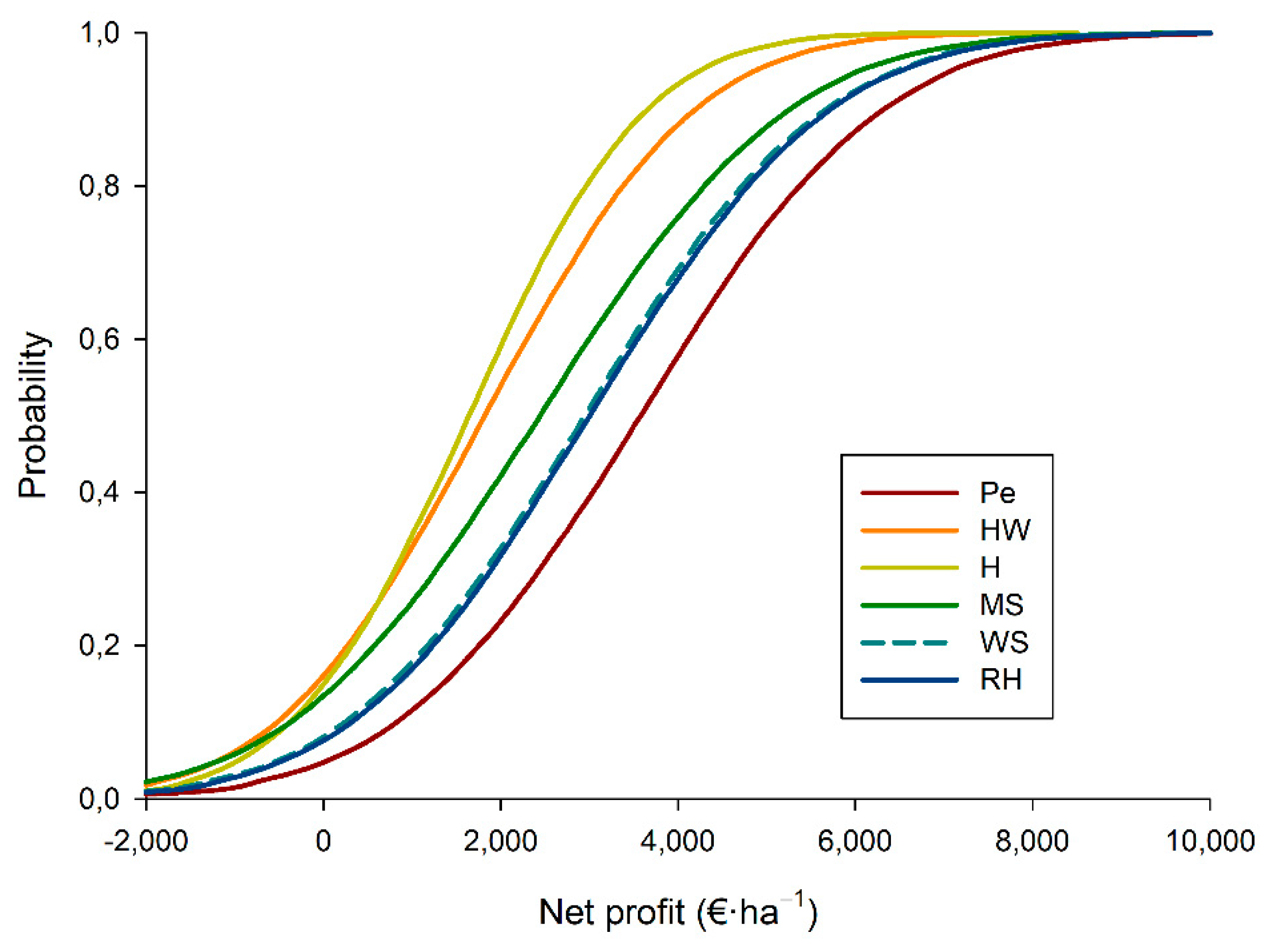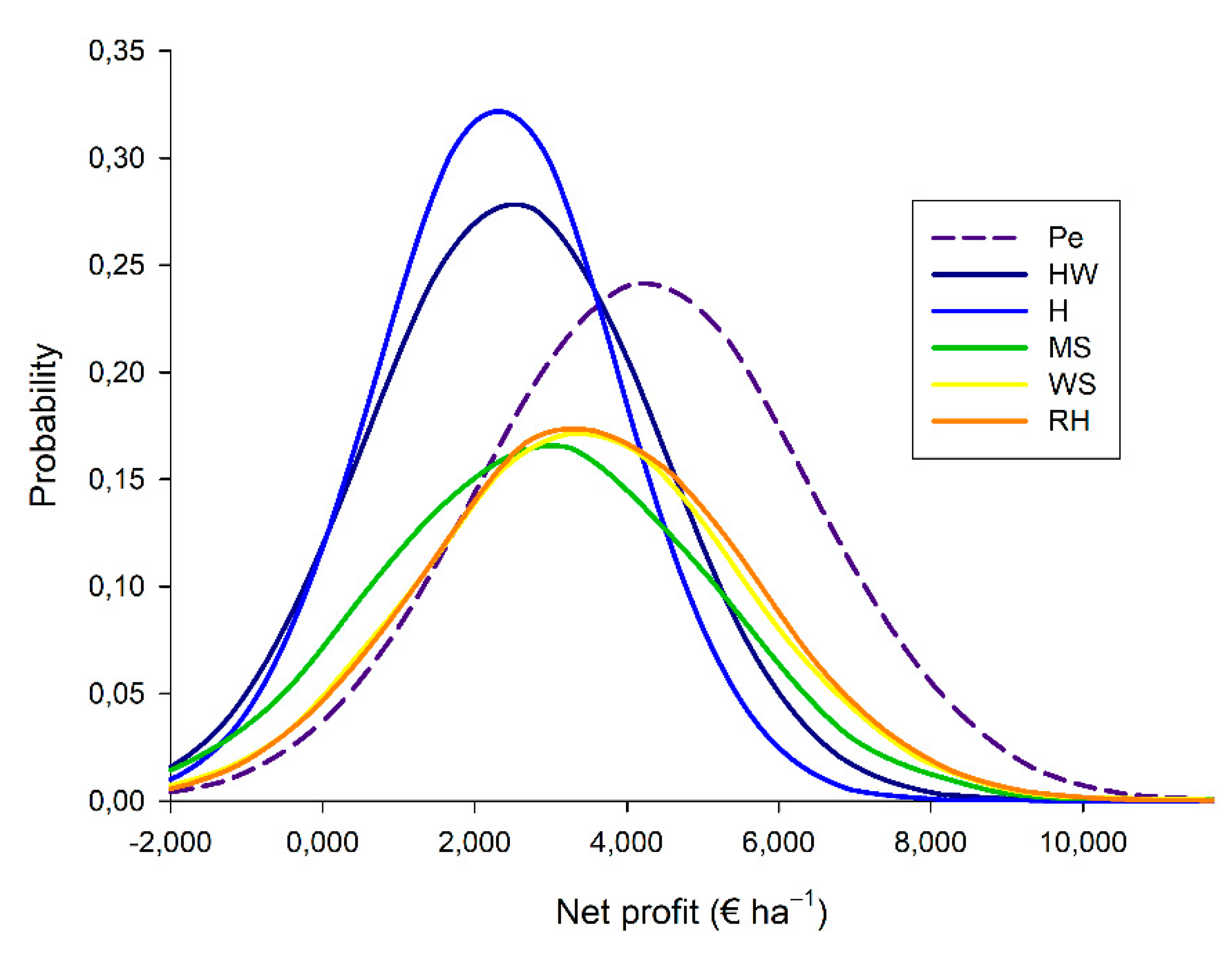1. Introduction
One of the great advances with regard to improving agronomic yields in crops in areas where water and the environmental conditions are limiting has been the use of plastic films for mulching [
1,
2,
3]. In the 1950s, plastic mulches began to be used, due to their ability to increase the soil temperature [
4]. Soil covers enhance total yields, control soil erosion, and suppress weed growth [
1,
5,
6,
7,
8]. In addition, mulches, by influencing the temperature and improving the physical structure of the soil, produce a microclimate that improves the productivity in the use of water and fertilizers [
9] and modifies the energy balance of the soil [
10].
The most used mulching material is low-density polyethylene (LDPe) since, among its physical properties, it exhibits good impact resistance, very good processability, thermal and chemical resistance, flexibility, and impermeability to water, in addition to being a cheap material [
6]. However, the use of LDPe provokes serious environmental concerns, because its manufacture requires fossil fuels and, since it is non-biodegradable, it causes a residue problem and has detrimental effects on the ecosystem [
11,
12,
13,
14].
Excessive use of LDPe mulches is leading to the accumulation of high amounts of plastic wastes, an environmental problem for agricultural ecosystems. After their use, most of these mulches (around 80%) accumulate in landfills or in natural ecosystems [
15]. Pieces of plastic from such wastes can be found in soils, water resources, and organisms, including humans [
16,
17,
18,
19,
20], with effects on the environment and on human health [
21,
22,
23]. The risks in terrestrial systems are less evident than in aquatic ones, since the waste is either buried or burned; however, in the aquatic environment it floats and travels long distances, or is deposited on the seabed [
24].
Recycling rates for mulches are significantly lower than the global plastic recycling rate, and are estimated to be below 30% [
25]. Furthermore, the problem is aggravated since the fragments that remain after the use of the mulch are difficult to collect and are of low value [
24].
Today, one of the new objectives of many governments is the transition to a more circular economic model, where the value of products, materials, and resources is maintained in the economy for as long as possible, and the generation of waste is minimized, reducing adverse health and environmental impacts [
26].
In this respect, the use of low-cost and available organic agricultural residues has been proposed for the production of biodegradable mulch materials [
27,
28], as a way to make weed management practices cost-effective, labor-efficient, and environmentally sound [
29].
Hydromulches have been proposed as an alternative to plastic mulches made of LDPe. Hydromulch can be defined as a mixture of water with some type of lignocellulosic material or polymers, plus other additives suitable for the particular purpose, which is applied not as a film but as a liquid [
30].
Hydromulching can be useful for the suppression of weed growth, where mechanical and chemical weeding are very difficult [
31,
32]. Hydromulches can persist for a long time on the ground, although this depends on environmental factors (temperature and moisture) [
33].
In recent years, some studies have been published in relation to the effect of hydromulching on the soil, but very few have dealt with its application in agriculture and the potential benefits for weed control, yield, and sustainability.
The specific aim of this work is to contribute new data to the literature by comparing the economic outcomes of two different forms of artichoke cultivation: with mulch (one plastic and three hydromulches) and without mulch (with and without herbicide). For each of these, the yields of two consecutive years will be valued, according to the market prices, to obtain the income, which will be compared with the operational costs to determine the viability of each alternative. Finally, a sensitivity analysis will determine the variability of the results obtained and the probabilities that the grower will incur losses or not.
2. Materials and Methods
The hydromulches consisted of different mixtures (blends). Recycled paper pulp and paper pinus pulp were used as the basic components and sodium silicate was used as a matrix for the hydromulch samples. To prepare the blends, in addition to paper pulp, the following crop products were used: wheat straw (WH), used mushroom (Agaricus bisporus) substrate (MS), and rice husk (RH). Three random cultivation blocks were established, with five treatments each: two-color low-density Pe (white/black, top/bottom), the three hydromulches (WS, RH, and MS), a treatment without mulching on bare soil where hand weeding was carried out (HW), and a treatment without mulching on bare soil where an herbicide was used (H). Each block comprised 25 plants.
Plants of artichoke (Cynara candunculus var. scolymus L.) cv. Symphony (Nunhens-BASF), grown from seed, were cultivated at the IMIDA agricultural experimental farm, located in Murcia (Spain) (latitude 37°45′ N, longitude 0°59′ W). They were transplanted on 8 August in the first year (2019) and on 1 August in the second (2020), the final harvests taking place on 28 and 16 March, respectively. The crop density was 5000 plants/ha. A standard nutrient solution for artichoke was used, applied through an underground drip irrigation system at a depth of 5 cm, with emitters of 4 L/h. The trials were conducted following the agricultural practices commonly used in commercial artichoke production in this area. Herbicide was applied four times in each of the two years of study, the herbicides employed being Assistan® 40SC, Reglone®, and Lentagam®.
Twelve and 10 harvests were carried out in the first and second years of study, respectively: the artichokes were harvested at their optimum collection time and weighed individually.
2.1. Economic Analysis
A cost–benefit analysis determines the benefit by comparison of the income and the costs of an investment project. As in other works [
34], an operational structure representative of southeastern Spain was used. Income was obtained as the product of the weekly yield (for each of the two years analyzed) and the average weekly price. Information on the market prices for artichokes was obtained from CARM [
35] and the average market prices from 2000 to 2020 were used, as well as their variability, measured as the standard deviation during said period, for the subsequent sensitivity analysis.
The costs are the averages of the values for the two years studied. The costs per hectare were estimated, separating the structure costs from the annual costs, in line with other studies [
36,
37]. Among the structure costs, a toolshed (with a useful life of 25 years), an irrigation pumping head (15 years), a localized irrigation network (10 years), a regulating reservoir (30 years), and various auxiliary materials (5 years) were considered. For all these costs, only the annual depreciation was allocated, obtained as the ratio between the acquisition price and the useful life. In addition, the two years of cultivation were considered, so the costs of preparation and planting as well as of the mulching materials and their installation were distributed between the two years. The costs of the mulching materials were obtained using the amount (kg) needed to cover one square meter and the square meters that needed to be covered in one hectare (4600 m
2). The annual costs were classified into weeding, herbicides, phytosanitary, fertilizers, irrigation water, etc. With regard to herbicides, where appropriate, 4 treatments were carried out and the amount of herbicide used was measured. Five phytosanitary treatments were carried out each year. The cost of water was €0.24 m
−3, based on the average cost of recent years, and 5250 m
3 ha
−1 were used. This cost is similar to that used in other studies, such as that of García-García et al. [
38], who considered a water cost of €0.23 m
−3. The cost of water shows great volatility by area [
39] and can reach €0.26 m
−3 [
40]. The harvesting costs were based on the weight (kg) of artichokes collected, considering a cost of €0.13 kg
−1. For the fixed personnel expenses, it was considered that one employee can manage 20 ha, while the hourly cost of the operators was established at €7.50 h
−1 and that of the tractor at €36 h
−1.
2.2. Productivity and Efficiency Analysis
For the analysis of the productivity with regard to the use of water, the water productivity in Euros per cubic meter of water [
41,
42]) was calculated. Also, the yield, the income per cubic meter, and the net profit per cubic meter were determined. Finally, the maximum price of water that the operation could support without incurring losses—The water viability threshold (WVT)—Was obtained [
43,
44].
Regarding the employment, the NAJ (number of agricultural jobs) per hectare and per cubic hectometer was calculated. To determine the employment generated, the labor used in different tasks, including the handling of machinery, was calculated. One unit of NAJ corresponds to 1840 h.
The envelopment DEA-CCR model has been used to analyse the efficiency of each technology considering water and labour efficiency as input variables [
45]
where Y is the output matrix for the six used technologies (production in kilos and net revenues have been considered), X is the input matrix (considering water and working hours),
is the weighted or intensity vector (nx1),
, (
is the intensity of unit j) and
denotes the punctuation of technical efficiency of unit 0.
The use of the DEA-CCR model for the efficiency analysis presents several limitations, such as the estimated frontier can be influenced by outliers, especially when the number of observations is too small; the model does not give information with regard to the theoretical optimum, and it is difficult to make estimations or to test hypothesis for the estimated parameters.
2.3. Sensitivity Analysis
In order to determine the effect of possible changes in the variables used on the results of this study, the Monte Carlo simulation was used. This methodology is based on the simultaneous change of all the variables that influence the variable under study; in this case, the yield per hectare. In this regard, the Monte Carlo simulation is especially suitable for the study of the effect of different variables on a given variable [
46]. This methodology is much more complete than others such as the coefficient of variation used in Smith et al. [
47] and Kiwia et al. [
48]. For this, the distribution function of each of the variables was estimated and data were generated from this distribution. The generation of 40,000 iterations allowed the results obtained to be studied. In each iteration, the net return for each year was obtained as the difference between income and expenses. Income was considered as the product of the yield and prices. The yield was considered as a normal variable, its mean being the average of both years and with a standard deviation obtained from the experiment itself. For the prices, we proceeded in a similar way, but considering the information from the last 20 years. Regarding the costs, although the overheads were considered fixed, since they were incurred in the first planting and cannot be altered during the rest of the useful life, the annual costs were also considered normal, with the mean values used throughout the text and the standard deviation obtained from the information provided by the various sources. Combined with this analysis, the Value at Risk (VaR) was used to determine the probability that the profit of each alternative (Pe, H, HW, etc.) is positive (or, in general, greater than a previously defined value).
Although the VaR was originally designed for use in financial institutions, its use is currently spreading in other sectors such as agriculture, as can be seen in the work of Manfredo and Leuthold [
49] and Brotons et al. [
50], who calculated the VaR to quantify the market risk of cattle feeders. In this sense, if we assume that X is a random variable with a cumulative distribution function F (X) and let VaR be a fixed value such that
then VaR is defined as the inverse of the function of the cumulative distribution
So, the VaR is the lowest value of a variable for a certain level of confidence α; that is, the value for which the α% of the possible values of said variable are less than said value, and the (1 − α)% is greater.
The confidence level for which net income is equal to zero (I = 0),
is the confidence level for which I = 0 can be obtained as the probability that I is lower or equal to zero.
2.4. Statistical Analysis
For the analysis of the yield and income of each treatment, the Levene test was used for the analysis of the homogeneity of variances. The non-existence of significant differences in the variance (p > 0.05) allowed the application of a one-way ANOVA to determine the existence of significant differences in yield and income among the treatments. When a difference was significant (p < 0.05), the treatment means were separated by Tukey’s honestly significant difference (HSD) multiple-range test, using lowercase letters to indicate significant differences between treatments. The statistical package used was SPSS 25 (Chicago, IL, USA).
4. Conclusions
Hydromulches are a good alternative for artichoke cultivation, for the reduction of plastic waste. In addition, their costs may be reduced by the mechanization of the installation process on the ground. Their use can reduce the carbon footprint, and is more sustainable and profitable as well as being ecofriendly. It is a technique that can be easily used in many other horticultural crops, although the availability in the area where the hydromulch will be used of the plant waste used to make it is important for its economic viability.
The main conclusions of the study are:
The yields, which showed little variability between the two years analyzed, were lower in the treatments without mulch: H (15% lower) and especially HW (29% lower). Therefore, the use of mulch increases the yield in a similar way to polyethylene, but also has environmental advantages.
The sale prices remained practically stable until they began to decrease in mid-February, reaching €0.33 kg−1 in April, 61% lower than at the beginning of the year.
Organic mulching had the highest costs (up to 5% higher than Pe) since the costs of the mulching materials were higher than for Pe. Research should now focus on reducing these costs in order to make such materials economically competitive with plastics.
The net profits with the mulching materials MS, WS, and RH were higher than for HW and H, but lower than for Pe. The profitability of the use of mulching materials may be reduced by the cost of transport if they are not available near the site of cultivation. It is clear that, if the objective is to reduce the environmental impact of the use of plastics and other polluting elements, the use of mulch should be carried out close to where the corresponding waste is generated to avoid the occurrence of externalities due to its transport.
Pe gave the highest productivity in the use of water, regarding yield and income, followed by WS and RH. When considering the productivity in euros, the most profitable treatments were RH and WS. The profit per cubic meter was lower for Pe due to the high acquisition costs of this material. The highest generation of employment (greatest number of jobs) corresponded to Pe (71.14 NAJ hm−3) and the lowest to H (45.36 NAJ hm−3).
According to the sensitivity analysis, the probability of negative results is 0.04 in Pe, 0.13 in SM, 0.08 in WS, and 0.07 in RH; so, the probability that the grower will obtain a profit is greater than 0.9 when using mulch (except mushroom substrate) or polyethylene. A future reduction in mulch costs would greatly reduce the probability that the grower will make a loss.
New work is required to corroborate the reasons for the agronomic differences among the different mulches, as well as studies on the decomposition of hydromulch remains (the C and N cycles in soil, and the availability of C and N to plant roots) and evaporation. Such work will reveal the system that is most effective and profitable, due to both the reduced evaporation and the enhanced bioavailability of nutrients resulting from the decomposition and mineralization of the mulch organic matter. The mulching materials selected in this way, and originating close to the site of cultivation, will be the most sustainable, both economically and environmentally.
